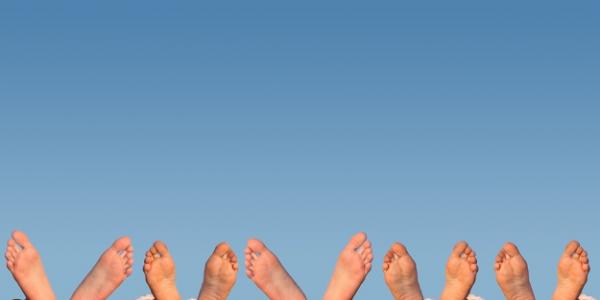
Feet on the Ground
At an Ayurvedic retreat in India recently, it was recommended that I walk on the grass barefoot. Later when I was wandering around the garden, post thunderstorm, it felt a tad awkward to discard my flip flops, but when I did, it felt so good. Surprisingly good in fact. The grass was velvety and springy underneath me, my feet and toes free to spread, my legs and whole body open to move naturally. I had this plugged in sensation and was totally energised as a result. It wasn’t just physical, but emotional too. It reminded me of all the long hot summers as a child being able to run around barefoot – the freedom and joy it gave me. Back then, the Doctor had recommended to my mum that both my sister and I walk around without shoes and socks whenever possible as a way to exercise our feet and toes, to develop strong arches. The Indian Ayurvedic Doctor had advised it more as an emotional experience – to feel connected to the earth – for a sense of grounding.
The idea of ‘grounding‘ is much talked about in yoga. That each posture works by a gravitational pull – feet rooted to the floor, the weight of the lower body from pelvis down pushing into the earth, the rest of the spine extending upwards towards the sky (or it might be hands and feet on the ground, sit bones reaching upwards in the case of Downward Facing Dog, the classic ‘v’ shaped inversion). Yogis call this the two way stretch, and it has a deeper spiritual meaning too – transcending our earthly selves to higher consciousness. The Lotus flower being the visual analogy, with its roots extending deep into the mud beneath the water, disguised by its flat leaves floating on the surface and beautifully exotic petals opening up to the light.
Higher states of consciousness aside, on a physical level, walking or running barefoot is the most natural thing in the world. After all, our feet are a bio-mechanically complex structure of 33 joints and 28 bones made to cushion, support and balance us on any surface. Crushing them into (mainly unsuitable) shoes not only leads to postural problems, but often means we’re shy of revealing them in public as grown-ups. Me included until I started practising yoga. Doing classes barefoot means my naturally flat feet are now stronger and healthier, plus they look prettier, less gnarly somehow.
It’s made me realise how key it is to exercise and keep them mobile – and you don’t need to be a full-on yogi to do this. Try standing with your feet parallel and slightly apart. Lift your 10 toes up and place them back down on the floor one by one, a bit like playing the piano. This can be quite hard at first as toes and their joints can be really inflexible. The more you do this, the more you feel your feet spread and in turn how this engages your legs, hips, and core affecting your whole posture and how you stand. One of my yoga mentors advises wearing toe separators at home – the foam ones we normally use to paint our nails. This helps toes spread, and feet find their natural width since most of the shoes we wear are too narrow.
Freeing our feet makes perfect sense – who doesn’t love the feeling of discarding shoes and socks immediately when we hit the beach – but it turns out there is more of a subtle wellbeing aspect to this. When I researched this a little more, the new age-y sounding concept of earthing came up. This is defined as the ‘practice of connecting the body with earth by touching skin to a conductive material such as grass (preferably wet), wet sand, a river, lake or sea’. The theory being that when the body loses contact with the earth (via the roads, pavements, rubber soled shoes of our urbanised lives) it can carry a positive voltage in comparison to the earth and walking barefoot brings the voltage back to zero. In turn, this is thought to allow electrons to flow into the body which help keep free radicals under check. (Free radicals are reactive oxygen species released during normal processes of metabolism. In the right dose, these help fight disease and bacteria, but out of balance can lead to premature ageing and inflammatory diseases such as Type 2 diabetes).
Although there are tiny studies which back up the theory of earthing, still, it’s left field thinking, as much as going barefoot is impractical in day to day life. We can, however make sure we ingest free radical fighting nutrients, namely Vitamins A, C and E in the form of fresh, colourful fruits and vegetables as well as good quality supplements. And of course, throw off our shoes and remember to feel the soles of our feet on the ground whenever we can.
DISCLAIMER: The views, opinions and information expressed in this article and on Victoriahealth.com Ltd are those of the author(s) in an editorial context. Victoriahealth.com Ltd cannot be held responsible for any errors or for any consequences arising from the use of the information contained in this editorial or anywhere else on the site. Every effort is made by the editorial and content team to see that no inaccurate or misleading information, opinion or statement appear, nor replace or constitute endorsement from medical bodies or trials unless specified. Victoriahealth.com Ltd accept no liability for the consequences of any inaccurate or misleading data, information, opinion or statement. Information on Victoriahealth.com Ltd and in the editorials is provided for informational purposes only and is not intended as a substitute for the advice provided by your physician or other healthcare professional. You should not use the information on this website or in the editorials for diagnosing or treating a health concern or disease, or for the replacement of prescription medication or other treatment.